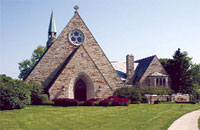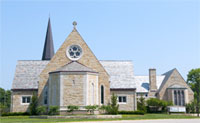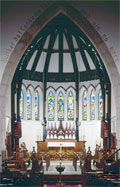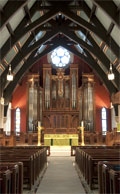|
Protecting history
Insuring historic structures requires careful attention to unique features
By Joseph J. Hunter-Lattak, CPCU, AIM, AMIM
From a property insurance standpoint, historic buildings contain inherent and
often unique values that require a higher degree of attention than modern
buildings. At the 2010 American Association of Insurance Services (AAIS) Main
Event, Dave Mistick, president of Circumspex LLC, a Pittsburgh-based firm that
helps organizations plan for and recover from disasters, addressed how the
design and construction of historic buildings makes them more vulnerable to
damage—especially by fire—and more expensive to repair after damage has occurred. And he provided a wide
range of suggestions for managing the risks associated with historic
structures.
Beyond the intrinsic characteristics of historic buildings, which increase the
complexity, risks and costs of insuring them, they also have to be analyzed
based on what goes on inside them. And since they are existing buildings,
materials and labor codes must be taken into account.
What exactly is a historic building? The term has more than one meaning. The
building itself may be historic. Or it may be a historic landmark, being a particular building in a locality. Or it
may be a certified historic rehabilitation, which is itself a Pandora’s box of complexity from the insurance, tax and claim standpoints. It may also
be a building with historic roots insofar as being an individual building or
site, or be part of a local, state or national district. Keep in mind that a
building may simply be old and not historic at all. The issues that follow
address historic buildings being preserved, rehabilitated, restored or
remodeled.
Preservation and rehabilitation projects are relatively simple, Mistick said,
because the buildings are in reasonably good condition and the work is less
intensive, although rehabilitation usually involves more tax codes. Restoration
and remodeling projects are dynamic and may require a hodge-podge of
considerations because they involve maintaining the current structure intact
while usually completely gutting and replacing most, if not all, of the
interior.
Other issues that arise are municipality controlled historic easements that
involve maintaining the building in a certain way using certain materials.
Various historic tax credits apply, depending on the building’s age and use, and the state historical organization as well as the federal U.S.
Department of the Interior must document these.
In determining the proper value, traditional methods such as market or
acquisition value, or replacement cost based on square footage, assembly costs, or unit costs usually don’t work. Mistick said that instead, the best and most reliable approach might be
the toughest to sell to an insurance company—using estimates from a specialty contractor who works in this niche. It is important to
remember that this cost estimate is driven by historic building components
added to regulatory requirements to arrive at a true replacement cost.
These projects have a number of other cost determinants (or cost drivers), not
the least of which is the availability of historic or similar materials, and
trade or craftsmen in the area to do the work. Costs can rise dramatically when
the skilled workers must be brought in from distant locations and when their
housing, meals and transportation costs must be provided in addition to their
wages. Other cost drivers are hazardous materials that must be handled (such as
asbestos abatement or lead paint removal), building codes, other regulatory
requirements, and tax credit certification.
Historic components are some of the most challenging issues and require an
expert to ferret out the potential pitfalls that await the owner or contractor.
Mistik provided the following examples:
• Plaster castings, carvings and table runs
• Decorative finishes and architectural embellishments
• Material issues, such as lead, latex, or milk paint
• Historic millwork such as hand carved vs. machine milled, including
architectural millwork/custom profiles and installation labor
• Historic flooring, such as exotic or first-growth forest products
• Decorative metals, “historic” mechanicals and equipment, and fine art murals
Building codes are an ever-present wild card issue because the extent of damage
defines code implications. Accessibility, seismic activity, and energy/HVAC
issues are building code considerations.
Full reinstatement insurance is a level of coverage that should enable the owner
to completely rebuild to the same design quality and style but, in case of a
total loss, in accordance with current legislation. Similarly, with partial
losses, it covers the cost to repair and rebuild the damaged and/or destroyed
parts. Compared to their modern counterparts, historic buildings are inherently
expensive to repair and rebuild.
As a result, the premium charge for full reinstatement insurance is usually
quite high. Owners may select lesser coverage with correspondingly lower
premiums, if the insurance company agrees, but the risk assumed because of
their reduced coverage must be considered carefully.
Mistick provided several recommendations concerning reinstatement of values:
• If the building has a historic value that would be destroyed or seriously
compromised by rebuilding in whole or in part, full reinstatement insurance may
not be necessary.
• If the building is part of a group of historic buildings in a conservation area
that would be greatly devalued if a single element were not rebuilt, full
reinstatement insurance may be necessary.
• If the building has a commercial value or interest that must be protected, such as obligations under a lease or mortgage, or where it is part of an
investment portfolio, full reinstatement insurance may be a contractual
requirement to protect such interests.
• If the premium charge for total reinstatement outweighs both the building’s historic or commercial value, a lesser form of insurance may be acceptable.
• Total losses are quite rare. The vast majority of losses are partial. It is
difficult to identify the point where a building is so damaged that full
reinstatement is not justified. However, a figure between 50% and 60% has been
suggested.
Other coverages to consider, according to Mistick, are:
• Contents coverage for items not permanently attached to the building, including
furnishings, works of art, collections, and certain external building features
• Engineering coverage for damage or loss of mechanical objects, such as
elevators, boilers, ventilation systems, and lifting equipment
• Liability coverage for claims for damage to persons or property made by
visitors and neighbors
• Consequential loss coverage for loss of business income or loss of profit that
applies to loss of revenue from visitors or rent and other consequential
financial loss, such as temporary relocation, removal and storage costs
• Terrorism coverage—this is usually excluded but separate coverage may be available and should be
considered, since many national historic landmarks in other countries have been
damaged by acts of terrorism.
• Green building issues introduced into historic buildings may significantly
increase the risk of damage or destruction, as such losses in historic
buildings in other parts of the world have demonstrated. Additional
precautionary steps should be taken and the insurance company should be
notified to arrange proper coverage.
Mistick pointed out three general areas in which historical buildings can
mitigate their level of risk:
• Design. With guidance by specialists, consider adding barriers that limit the
spread of fire and smoke in conjunction with implementing fire detection and
fighting systems above and beyond statutory minimum requirements. Review
combustibility and damageability of components and finishes and consider
implementing issues that reduce the chance of fire. Review heat sources inside
the building and find ways to reduce the risk of their becoming sources of
fire.
• Historic buildings are most prone to loss during construction. Access must be
restricted and escape routes, fire detection systems, and fire-fighting systems
should be maintained. Equipment that uses exposed flames or sparks should not
be used inside the building and hot work permits should be required. Compounds
containing flammable solvents should be avoided, trash removed daily, good
housekeeping maintained at all times, and all work areas inspected and cleared
at the end of each work day.
• Management should issue standing orders concerning regular testing of heat
producing equipment, fire detection, and fire fighting systems. Smoking must be
controlled and all areas inspected regularly. Fire evacuation and salvage
drills should be developed and practiced regularly.
Risk management and insurance on historic buildings is complex and requires considerable thought and planning, in many cases even above and beyond the points indicated above.
| ONE HISTORIC RENOVATION |

Before |

After |

Before |

After |
In a recent renovation and enlargement of St. Paul’s Episcopal Church, Indianapolis, Indiana, the building was gutted and the worship space turned 180 degrees. Many of the liturgical fittings had been brought from the original 1866 church building, so attention had to be paid to their removal, storage and eventual placement in the new environment. Other historic pieces of furniture and art work required the same careful treatment.
Updates were made to the handicapped facilities, including an elevator. Energy/HVAC issues required updating of those facilities; attention had to be paid to building codes regarding fire and smoke barriers, as well as the prevention of damage from sprinkler systems. Particular attention had to be paid to the prevention of fire and water damage during construction. And, as with most old buildings, asbestos abatement and lead paint issues became part of the renovation picture.
The two photos (above) show the changes that occurred when the sanctuary of St. Paul’s church was “flipped” and the old front entrance became the new altar space (right). Inside what was the original front entry, the new chancel houses an original stained glass window and liturgical items as well as the new altar, organ and choir seats. |
|